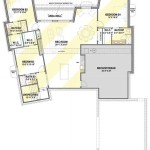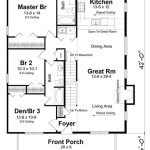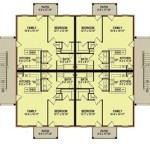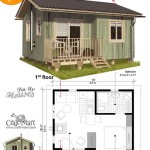Walk-In Closet Floor Plan Dimensions: A Comprehensive Guide
Walk-in closets offer a luxurious and organized storage solution, providing ample space for clothing, shoes, accessories, and other personal belongings. Designing an efficient and functional walk-in closet necessitates careful consideration of floor plan dimensions. This article provides a comprehensive guide to understanding the key dimensions involved in planning a walk-in closet, ensuring optimal space utilization and ease of use.
Proper dimensions are crucial for several reasons. Inadequate space can lead to overcrowding, making it difficult to find and access items. Conversely, an excessively large closet may represent wasted space that could be better utilized in other areas of the home. The optimal dimensions strike a balance between storage capacity and efficient use of available square footage, considering the user's needs and the architectural constraints of the space.
Minimum Walk-In Closet Dimensions
The minimum acceptable dimensions for a walk-in closet are generally considered to be 4 feet wide by 4 feet deep. This provides sufficient space for a single hanging rod on one side and enough room to step inside and access the clothing. However, this configuration is quite basic and may feel cramped, particularly for larger individuals or those with extensive wardrobes. While technically meeting the definition of a walk-in closet, a 4x4 foot space offers minimal flexibility in terms of storage options and maneuverability. It's more akin to a very deep reach-in closet than a truly functional walk-in space. The primary advantage of these minimal dimensions is their ability to fit into smaller areas of a home where space is limited. This size is best suited for individuals with a minimalist wardrobe or for storing seasonal clothing.
To enhance the functionality of a small walk-in closet, optimizing vertical space is essential. Installing shelves above the hanging rod can provide additional storage for folded clothes, shoes, or accessories. Utilizing the back of the door for hanging organizers can also help maximize storage in a limited space. Proper lighting is also crucial to make the most of the available space and improve visibility inside the closet. A well-placed light fixture can make the closet feel larger and more inviting. Mirror installation can also enhance the sense of spaciousness. Ultimately, while a 4x4 foot walk-in closet is viable, creative organization and efficient space utilization are paramount.
Ideal Walk-In Closet Dimensions
For a more comfortable and functional walk-in closet experience, a minimum of 6 feet wide by 8 feet deep is recommended. This allows for hanging rods on both sides of the closet, with adequate space to walk between them. This configuration provides significantly more storage capacity and allows for better organization. With this size, it's possible to incorporate drawers, shelves, and other organizational features without feeling cramped. The additional depth also provides room for a full-length mirror, which is a desirable feature for many users.
A walk-in closet of this size offers greater flexibility in terms of design. It allows for the creation of distinct zones for different types of clothing, such as hanging areas for dresses and suits, shelving for folded items, and specialized storage for shoes and accessories. The increased width also allows for the inclusion of a small bench or ottoman, providing a comfortable space to try on shoes or plan outfits. Furthermore, a 6x8 foot closet can comfortably accommodate two users, making it a suitable option for couples. With careful planning and a well-designed layout, a walk-in closet of this size can provide ample and well-organized storage for a variety of clothing and accessories.
In this size range, consider incorporating adjustable shelving systems. These systems allow for customization of the storage space to accommodate different clothing types and changing needs. Lighting is even more crucial in a larger walk-in closet. Consider multiple light sources, including overhead lighting and task lighting, to ensure adequate illumination throughout the space. A well-lit closet makes it easier to find items and prevents clothing from getting lost in the shadows. The incorporation of drawers also provides a closed storage option, ideal for delicate items like undergarments or accessories.
Luxury Walk-In Closet Dimensions
For those with ample space and a desire for a truly luxurious walk-in closet experience, dimensions of 10 feet wide by 10 feet deep or larger are ideal. These dimensions allow for a fully customized and personalized storage space, with ample room for all types of clothing, shoes, and accessories. Luxury walk-in closets often incorporate features such as dressing areas, seating areas, and even built-in vanity spaces. These larger closets can be designed to resemble small boutiques, providing a sophisticated and elegant space for organizing and displaying clothing.
In a luxury walk-in closet, the possibilities for storage and organization are virtually limitless. Custom-built cabinetry, adjustable shelving systems, and specialized storage solutions for shoes, handbags, and jewelry are common features. A central island can provide additional storage and countertop space, as well as a convenient surface for folding clothes or laying out outfits. In addition to ample storage, luxury walk-in closets often incorporate design elements such as chandeliers, custom lighting, and decorative mirrors to create a visually stunning and inviting space.
The larger dimensions also allow for the inclusion of a dedicated dressing area with a comfortable seating area, a full-length mirror, and ample lighting. A built-in vanity can provide a convenient space for applying makeup or styling hair. Consider dedicated storage for seasonal clothing, ensuring that items are easily accessible when needed and properly stored when not in use. Ultimately, a luxury walk-in closet is a reflection of personal style and organizational preferences, providing a tailored solution for managing a large and diverse wardrobe.
Factors Influencing Walk-In Closet Dimensions
Several factors influence the optimal dimensions of a walk-in closet. These include the size of the available space, the user's individual storage needs, and the overall design of the home. The size of the available space is often the most significant constraint, as the closet must fit within the existing architectural footprint. However, it's important to consider the user's storage needs when determining the dimensions. Someone with a large wardrobe will require more storage space than someone with a minimalist style.
Another key factor is the user's personal preferences for organization. Some individuals prefer to hang all of their clothing, while others prefer to fold items on shelves or in drawers. The design of the closet should accommodate these preferences. For example, someone who prefers to hang clothing will require more hanging space, while someone who prefers to fold items will need more shelving or drawer space. Also, consider whether the closet will be shared by multiple users. Shared closets may require additional space to accommodate the needs of each user.
The overall design of the home can also influence the dimensions of the walk-in closet. In some cases, the closet may need to be integrated seamlessly into the existing architectural style. In other cases, the closet may be designed as a statement piece, adding visual interest to the room. Furthermore, accessibility considerations should be taken into account, ensuring that the closet is easily accessible for all users, including those with mobility limitations. This may involve incorporating wider doorways or lower shelving to improve accessibility.
Standard Hanging Space Dimensions
Understanding standard hanging space dimensions is crucial for planning a walk-in closet layout. The height of hanging rods will vary depending on the type of clothing being stored. For short-hanging items such as shirts, blouses, and skirts, a minimum height of 40 inches from the floor is recommended. For long-hanging items such as dresses and coats, a minimum height of 68 inches from the floor is necessary. These dimensions ensure that clothing can hang freely without dragging on the floor.
The depth of hanging space should also be considered. A minimum depth of 24 inches is required to accommodate standard clothing hangers. This allows for enough space for clothing to hang without being compressed against the back wall of the closet. If installing shelves above the hanging rod, ensure that there is sufficient clearance to easily access the clothing. A clearance of 12 to 18 inches between the hanging rod and the shelf is generally sufficient.
The width of hanging space will depend on the number of items being stored. As a general rule, allow approximately 1 inch of hanging space per garment. This allows for adequate space between items, preventing them from becoming wrinkled or damaged. When planning the layout of a walk-in closet, it is also important to consider the placement of hanging rods in relation to other storage features, such as shelves and drawers. Optimizing the configuration of hanging space can significantly improve the overall functionality and efficiency of the closet.
Shelf and Drawer Dimensions
Shelving and drawers are essential components of a well-organized walk-in closet. Shelving is ideal for storing folded clothing, shoes, and accessories, while drawers provide a more private and protected storage option for delicate items. The dimensions of shelves and drawers will vary depending on the items being stored and the available space. For folded clothing, a shelf depth of 12 to 16 inches is generally sufficient. Shelves for shoes may be shallower, with a depth of 8 to 12 inches.
Drawer dimensions will depend on the type of items being stored. Small drawers are ideal for storing socks, underwear, and other small items. Medium drawers are suitable for storing shirts, sweaters, and pants. Large drawers can be used for storing bulky items such as bedding or blankets. The height of drawers should also be considered. Shallow drawers are ideal for storing flat items, while deeper drawers are suitable for storing bulkier items. Drawer glides are important for smooth and easy operation, especially for larger drawers.
The placement of shelves and drawers within the walk-in closet should also be carefully considered. Shelves are typically placed above or below hanging rods, while drawers may be incorporated into a built-in dresser or cabinet. Optimizing the placement of shelves and drawers can significantly improve the overall organization and functionality of the closet. Additionally, consider adjustable shelving systems to allow for customization of the storage space to accommodate changing needs.

6 Feet Wide Walk In Closet Master Design Dimensions Organizing

Finding Extra Space Bonus Walk In Closet Floor Plan With Dimensions Planning Master Layout

Narrow Walk In Closet Dimensions Google Search Size

Master Suite Design Dream Closet Dimensions Features And Layout Forward Build Remodel

Walk In Closet Size Designs For Floor Plans Layout Dimensions

Closet Shelving Layout Design Thisiscarpentry Bedroom Planning

Walk In Closet Dimensions Guidelines With Drawings Upgradedhome Com
Closet Layouts Dimensions Drawings Com

Closet Genius How To Nail Your Master Layout The First Time

How To Plan And Design A Walk In Closet Sawdust Girl








